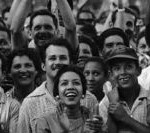August 2015

Doctors examine boys in the Prudente de Morais school in São Paulo. “A Cigarra” journal, 1914. São Paulo State Public Archives.
From the second half of the nineteenth century to the start of the twentieth, various countries began to institutionalize and disseminate public education as part of a project with a wider scope that attributed to education the ability to civilize, to provide physical and moral regeneration and social prophylaxis. This investment included intervening in the development of children’s bodies and minds, marked, among other objectives, by the intent to produce scientific knowledge on children to serve as a basis for organizing the various aspects of educational institutions. These include student grouping, definition of the content to be taught to each age group, and the teaching methods to be adopted.
Questioning the constitution of childhood as an object of study and intervention, as part of the process of disseminating public schooling, Heloísa Helena Pimenta Rocha’s article Between the examination of children’s bodies and the shaping of racial norms: aspects of the activities of the São Paulo State School Medical Inspection Service seeks to examine discursive and institutional practices implemented based on the attempt to shape the bodies and minds of children focusing on the relationships between the intervention proposals formulated in the field of medicine and their implementation in school settings.
Through this means, the researcher sought to identify some of the strategies through which authorities attempted to subordinate the teacher’s authority to that of the physician in children’s education. Among these strategies, the author highlights those that resulted in the introduction, in daily school activities, of the figure of the school doctor, equipped with modern resources and able to determine the individual characteristics on which the grouping of students should be based and to guide pedagogical work.
Rocha explains:
“To this end, we sought to analyze aspects of the São Paulo State School Medical Inspection Service (Inspeção Médica Escolar, IME), specifically those related to the practice of individual student examinations, attempting to understand their purpose, their role in establishing standards of normality and abnormality, as well as the racial component present in these practices.”

Doctors examine girls in the Prudente de Morais school in São Paulo. “A Cigarra” journal, 1914. São Paulo State Public Archives.
The source articles were published between 1904 and 1914 in the periodical Imprensa Médica (Medical Press), a biweekly publication owned by physician Balthazar Vieira de Mello, who became the director of the IME when it was established in 1911. Two works written by the physician were also examined, A higiene na escola (Hygiene in the schools) (1902) and Higiene escolar e pedagógica para uso de médicos, educadores e estabelecimentos de ensino (Scholastic and pedagogical hygiene for use by physicians, educators and schools) (1917). The former was published under the auspices of the State of São Paulo, at a time when Vieira de Mello worked as a health inspector for the Sanitary Service, obtaining significant experience in combating the epidemics that raged within the state. The latter was written around the time he transferred from the Health Service IME to the General Board for Public Instruction. In order to monitor the operational records of this organization, under the jurisdiction of the Secretary of Education, the author consulted the Anuários do ensino (Teaching yearbooks), the official publication of the General Board for Public Instruction for the years 1917 and 1918.
This set of sources, produced in the context of a debate between medical professionals, as well as the activities of a new department during its transition between the Secretary of Health and the Secretary of Education, provides significant evidence to enable understanding of the proposals that guided the actions of school physicians in São Paulo and, especially, the place and meaning of individual examination practices as part of the interventions carried out by the department.
Read the full article in HCS-Manguinhos:
ROCHA, Heloísa Helena Pimenta. Between the examination of children’s bodies and the shaping of racial norms: aspects of the activities of the São Paulo State School Medical Inspection Service. Hist. cienc. saude-Manguinhos [online]. vol.22, n.2, Apr./Jun.2015
See the full summary of HCS-Manguinhos vol.22, n.2, Apr./Jun. 2015 edition.
How to cite this post [ISO 690/2010]:
ROCHA, Heloísa Helena Pimenta. Between the examination of children’s bodies and the shaping of racial norms: aspects of the activities of the São Paulo State School Medical Inspection Service. Hist. cienc. saude-Manguinhos [online]. 2015, vol.22, n.2 [viewed DD MM YYYY], pp. 337-353 . Available from: <http://www.scielo.br/scielo.php?script=sci_arttext&pid=S0104-59702015000200005&lng=pt&nrm=iso&tlng=en> ISSN 1678-4758.






